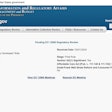
Diabetes is a leading cause of death and disability in the U.S. and around the world. It increases the risk for heart disease, end-stage renal disease, blindness, amputation, and complications of pregnancy. Globally, an increasing amount of money is spent annually on hemoglobin A1c (HbA1c) testing, both professional and self-testing, reaching sales of $1.5 billion, according to a new report from Kalorama Information.
HbA1c has been used since the 1990s to measure long-term glycemic control in diabetics. Glycated hemoglobin (glucose attached to the blood protein hemoglobin) is a well-established analyte for long-term evaluation of blood sugar control, but glucose has been the primary test for diagnosing the disease. Ideally, every insulin-dependent diabetic should be tested for HbA1c every three months.
 Bruce Carlson of Kalorama Information.
Bruce Carlson of Kalorama Information.The test has many positive features; for example, it can be conducted at any time of day without fasting. For more than 20 years, measuring HbA1c has been the gold-standard assay to monitor glycemia and guide treatment decisions for diabetes patients, even though there has not been significant data to support the relationship between HbA1c and average blood glucose. In the past few years, this question has been laid to rest.
Demand for the test has been spurred in part by several test guidelines. In 2009, the American Diabetes Association recommended using HbA1c to diagnose diabetes, with levels of 6.5% for diagnosis and 5.7% to 6.4% as an indication of increased risk. Compared with fasting plasma glucose and oral glucose tolerance tests, HbA1c measurement is less affected by the day-to-day variation of glucose levels and always reflects an average blood glucose level of the past 90 to 120 days.
In 2016, the U.S. Preventive Services Task Force (USPSTF) recommended screening for abnormal blood glucose as part of cardiovascular risk assessment in adults ages 40 to 70 years who are overweight or obese or who have a first-degree relative with diabetes. Also considered to be at risk are women who had gestational diabetes or polycystic ovarian syndrome, as well as African Americans, American Indians/Alaska Natives, Asian Americans, Hispanics/Latinos, and Native Hawaiians/Pacific Islanders.
These developments greatly increased the demand for HbA1c testing. In light of the high demand, just about every major clinical chemistry analyzer now has an HbA1c test in the menu, including Abbott's Architect c systems, Beckman Coulter's UniCel DxC 600/800, Bio-Rad's D-10/Variant II and Variant II Turbo, Roche's cobas Integra/6000/c 311, Siemens's Dimension series, and Tosoh's HLC-723G7.
Kalorama is forecasting growth for the global HbA1c testing market of 10.3% every year between 2019 and 2024, reaching $2.4 billion at the end of that period. A major contributing factor to growth is the increasing availability of HbA1c testing at both the professional and self-testing levels. The self-testing portion will be driven by the availability of mail-in, home-collected sample lab services. These lab services offer patients an essential value-added component of test interpretation and physician consultation without the need to leave home.
Bruce Carlson is the publisher of Kalorama Information, part of Science and Medicine Group. More information is available in Kalorama's report, titled "The World Market for HbA1c Tests."
Disclosure: LabPulse.com is a sister company of Kalorama Information.



















